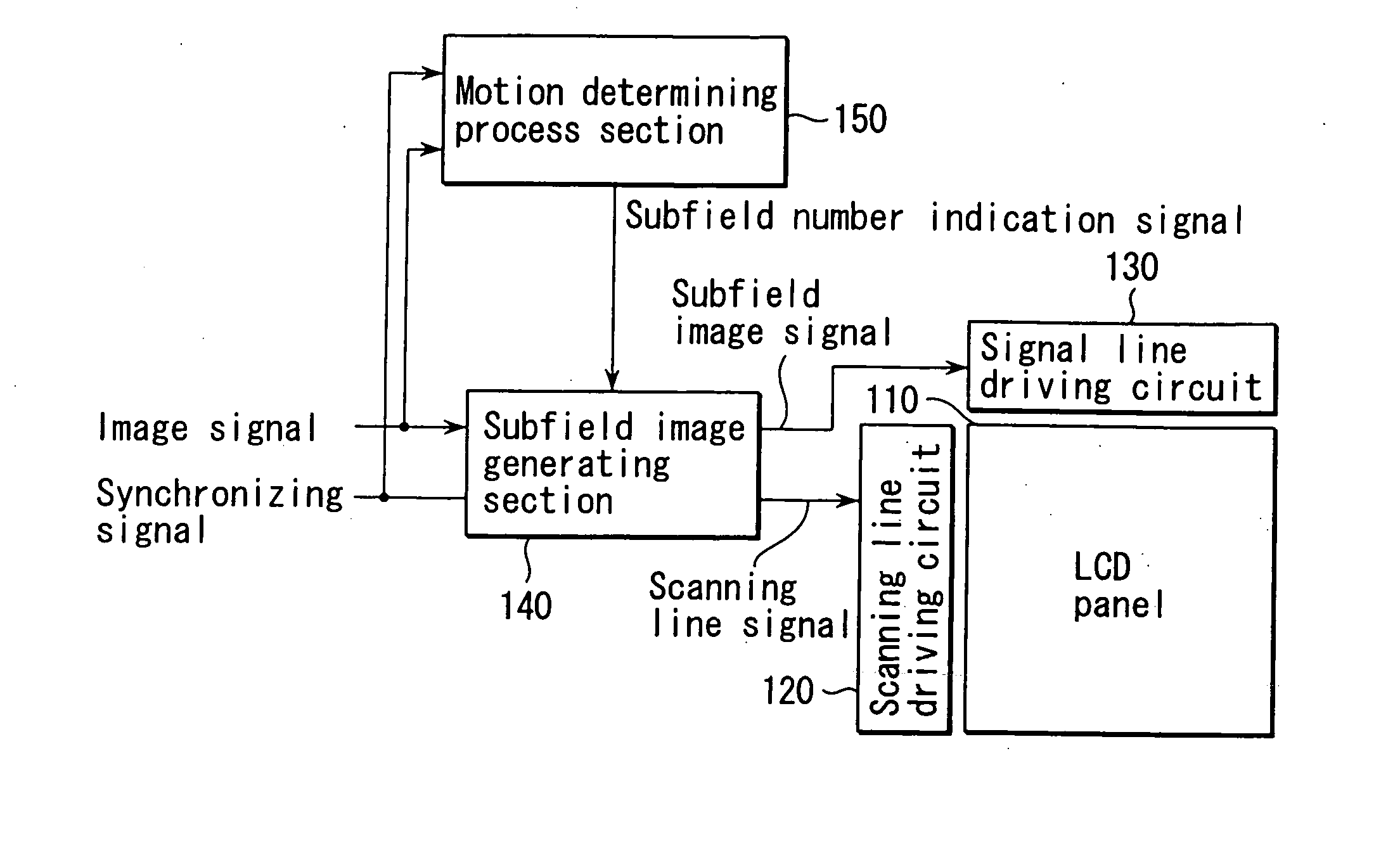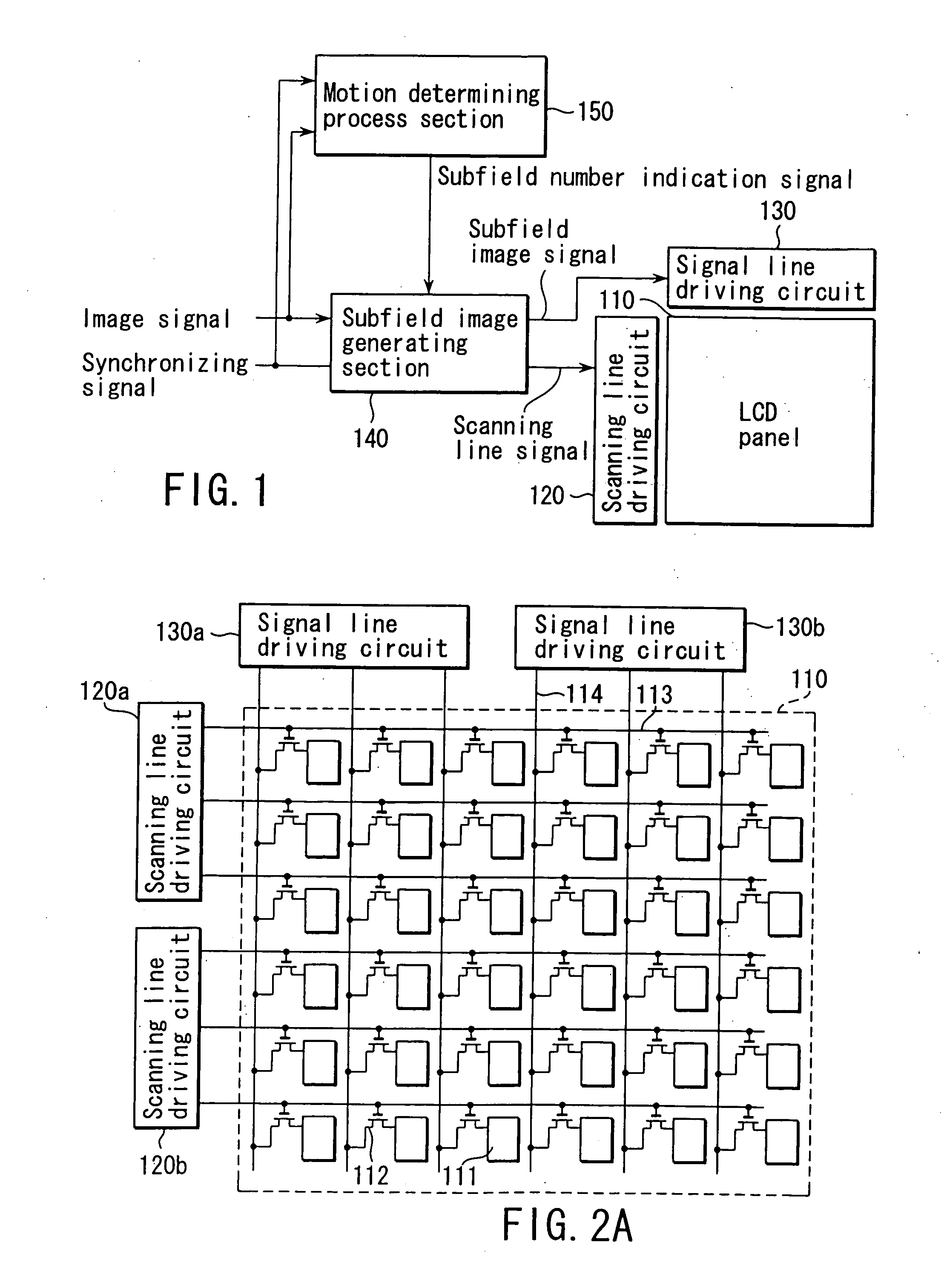Image display method
a technology of image display and display method, which is applied in the direction of instruments, television systems, signal generators with optical-mechanical scanning, etc., can solve the problems of difficult to strictly set the duty ratio, display uniformity, and possible blue phenomenon
- Summary
- Abstract
- Description
- Claims
- Application Information
AI Technical Summary
Benefits of technology
Problems solved by technology
Method used
Image
Examples
first embodiment
[0050] First, a first embodiment of the present invention will be described.
[0051]FIG. 1 is a block diagram schematically showing the configuration of a liquid crystal display device according to embodiments of the present invention. FIG. 2A is a diagram showing the configuration of a liquid crystal display module section (a liquid crystal display panel and peripheral circuits), shown in FIG. 1.
[0052] The liquid crystal display module section is composed of a liquid crystal display panel 110, a scanning line driving circuit 120 (120a, 120b) and a signal line driving circuit 130 (130a, 130b). The scanning line driving circuit 120 is supplied with a scanning signal by a subfield image generating section 140. The signal line driving circuit 130 is supplied with a subfield image signal by a subfield image generating section 140. Further, an image signal and a synchronizing signal are input to the subfield image generating section 140 and a motion determining process section 150. The s...
second embodiment
[0069] Now, a second embodiment of the present invention will be described.
[0070] In this embodiment, compared to the first embodiment, the first subfield has the lowest brightness, and the subsequent fields have a sequentially increasing brightness.
[0071]FIGS. 8A, 8B, and 8C show an example of this embodiment. As in the example shown in FIGS. 6A to 6D, FIG. 8A shows the brightness of the pixels of an input image. FIG. 8B shows an example in which images with the same brightness are displayed in the first and second subfields, respectively. In this example, a first and second subfield images (c-1) and (c-2) are generated in a brightness ratio R of 1 / 3 so that the average brightness is as shown in (c-3), as shown in FIG. 8C. Any remainder of the division between the two brightness values is added to or subtracted from the corresponding brightness in the first subfield.
[0072] The occurrence of color noise differs between the method of gradually increasing the brightness as in this ...
third embodiment
[0089] Now, a third embodiment of the present invention will be described.
[0090] The brightness in the screen may have a varying value. Accordingly, brightness may be set which exceeds the range of brightness at which the display device can display images. For pixels for which such brightness is set, the maximum possible brightness is set for a high-brightness image, whereas a brightness component exceeding the maximum brightness is set for an interpolation image.
[0091]FIGS. 11A to 11C show an example of this embodiment. As in the example shown previously, FIG. 11A shows the brightness of the pixels of an input image. FIG. 11B shows the case in which the brightness ratio R is set to 3. FIG. 11C shows the case in which the brightness ratio R is set to 1 / 3. In the description given below, the coordinates of the upper left pixel are defined as (0, 0) for convenience.
[0092] For example, as shown in FIG. 11A, it is assumed that the central pixel (coordinates (1, 1)) has a brightness o...
PUM
| Property | Measurement | Unit |
|---|---|---|
| frequency | aaaaa | aaaaa |
| frequency | aaaaa | aaaaa |
| subfield frequency | aaaaa | aaaaa |
Abstract
Description
Claims
Application Information
 Login to View More
Login to View More - R&D
- Intellectual Property
- Life Sciences
- Materials
- Tech Scout
- Unparalleled Data Quality
- Higher Quality Content
- 60% Fewer Hallucinations
Browse by: Latest US Patents, China's latest patents, Technical Efficacy Thesaurus, Application Domain, Technology Topic, Popular Technical Reports.
© 2025 PatSnap. All rights reserved.Legal|Privacy policy|Modern Slavery Act Transparency Statement|Sitemap|About US| Contact US: help@patsnap.com



